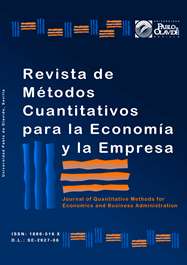Probability of default in infrastructure projects: analysis from structural models of credit risk
DOI:
https://doi.org/10.46661/revmetodoscuanteconempresa.3508Keywords:
credit risk, default probability, stochastic processesAbstract
The purpose of this paper is to estimate the default probabilities in infrastructure projects. For that, we analyze the exposure of the lenders to a state of default. This application is made by assuming the debt service coverage ratio (DSCR) dynamic itself and the payment profile determined by the available cash flow of the project, where these are stochastically modeled following the same assumptions of the valuation theory of options developed by Black and Scholes (1973) and Merton (1973). In this way, through the adaptation of structural models developed for illiquid assets, as an extension of the credit risk models of Merton (1974) and KMV of Moody's, the probability, exposure and loss components of the lenders are analyzed in scenarios of default.
Downloads
References
Aragones, J., Blanco, C., & Iniesta, F. (2009). Modelizacion del riesgo de credito en proyectos de infraestructuras. Innovar, 19(35), 65-80.
Basel Committee on Banking Supervision (2004). Basel II: International Convergence of Capital Measurement and Capital Standards: a Revised Framework. Bank for International Settlements, Basel.
Black, F., & Cox, J. (1976). Valuing corporate securities: Some effects of bond indenture provisions. The Journal of Finance, 31(2), 351-367.
Black, F., & Scholes, M. (1973). The Pricing of Options and Corporate Liabilities. The Journal of Political Economy, 81(3), 637-654.
Blanc-Brude, F., & Hasan, M. (2016). A Structural Model of Credit Risk for Illiquid Debt. The Journal of Fixed Income, 26(1), 6-19.
Blanc-Brude, F., Hasan, M., & Ismail, R (2014). Unlisted Infrastructure Debt Valuation & Performance Measurement. EDHEC-Risk Institute Publications.
Blanc-Brude, F., Hasan, M., & Whittaker, T. (2016). Cash Flow Dynamics of Private Infrastructure Project Debt: Empirical evidence and dynamic modelling. EDHEC-Risk Institute Publications.
Blanc-Brude, F., Hasan, M., & Whittaker, T. (2018). Calibrating credit risk dynamics in private infrastructure debt. The Journal of Fixed Income, 27(4), 54-71.
Blanc-Brude, F., & Strange, R. (2007). How Banks Price Loans to Public-Private Partnerships: Evidence from the European Markets. Journal of Applied Corporate Finance, 19(1), 94-106.
Borgonovo, E., & Gatti, S. (2013). Risk analysis with contractual default. Does covenant breach matter? European Journal of Operational Research, 230(2), 431-443.
Boussabaine, A. (2013). Risk pricing strategies for public-private partnership projects. New York: John Wiley & Sons.
Brandão, L., Dyer, J., & Hahn, W. (2012). Volatility estimation for stochastic project value models. European Journal of Operational Research, 220(3), 642-648.
Buscaino, V., Caselli, S., Corielli, F., & Gatti, S. (2012). Project finance collateralised debt obligations: An empirical analysis of spread determinants. European Financial Management, 18(5), 950-969.
Cartea, Á., & Figueroa, M. (2005). Pricing in Electricity Markets: A Mean Reverting Jump Diffusion Model with Seasonality. Applied Mathematical Finance, 12(4), 313-335.
Copeland, T., & Antikarov, V. (2001). Real Options: A practitioner´s guide. New York: Texere Publishing Limited.
Della, R., & Yermo, J. (2013). Institutional investors and infrastructure financing. OECD Working Papers on Finance, Insurance and Private Pensions, No. 36, OECD Publishing.
Dong, F., Chiara, N., Kokkaew, N., & Xu, A. (2012). Copula-Based Portfolio Credit Risk Assessment in Infrastructure Project Financing. Journal of Private Equity, 15(2), 31-40.
Freydefont, M. (2001). An Approach to Credit Risk Valuation for Structured and Project Finance Transactions. Journal Of Project Finance, 6(4), 53-67.
Gatti, S. (2008). Project finance in theory and practice: designing, structuring, and financing private and public projects. Oxford: Academic Press.
Gatti, S., Rigamonti, A., Saita, F., & Senati, M. (2007). Measuring Value-at-Risk in project finance transactions. European Financial Management, 13(1), 135-158.
Grimsey, D., & Lewis, M. (2002). Evaluating the risks of public private partnerships for infrastructure projects. International Journal of Project Management, 20(2), 107-118.
Ingersoll, J. (1977). A contingent-claims valuation of convertible securities. Journal of Financial Economics, 4(3), 289-321.
Karminsky, A., & Morgunov, A. (2016). The assessment of the credit risk of investment projects. XVI прельская международная научная конференция по проблемам развития экономики и общества. Moscú, National Research University Higher School of Economics, 721-731.
Kealhofer, S. (1993). Portfolio management of default risk. KMV Corporation.
Klompjan, R., & Wouters, M. (2002). Default Risk in Project Finance. The Journal of Structured Finance, 8(3), 10-21.
Kong, D., Tiong, R., Cheah, C., Permana, A., & Ehrlich, M. (2008). Assessment of Credit Risk in Project Finance. Journal of Construction Engineering and Management, 134(11), 876-884.
McQuown, J. (1993). Market vs. accounting based measures of default risk. KMV Corporation.
Merton, R. (1973). Theory of Rational Option Pricing. Bell Journal of Economics and Management Science, 4(1), 141-183.
Merton, R. (1974). On the Pricing of Corporate Debt: The Risk Structure of Interest Rates. The Journal of Finance, 29(2), 449-470.
Vasicek, O. (1984). The philosophy of credit valuation: the credit valuation model. KMV Corporation.
Yescombe, E. (2002). Principles of Project Finance. San Diego: Academic Press.
Downloads
Published
How to Cite
Issue
Section
License
Copyright (c) 2020 Journal of Quantitative Methods for Economics and Business Administration

This work is licensed under a Creative Commons Attribution-ShareAlike 4.0 International License.
Submission of manuscripts implies that the work described has not been published before (except in the form of an abstract or as part of thesis), that it is not under consideration for publication elsewhere and that, in case of acceptance, the authors agree to automatic transfer of the copyright to the Journal for its publication and dissemination. Authors retain the authors' right to use and share the article according to a personal or instutional use or scholarly sharing purposes; in addition, they retain patent, trademark and other intellectual property rights (including research data).
All the articles are published in the Journal under the Creative Commons license CC-BY-SA (Attribution-ShareAlike). It is allowed a commercial use of the work (always including the author attribution) and other derivative works, which must be released under the same license as the original work.
Up to Volume 21, this Journal has been licensing the articles under the Creative Commons license CC-BY-SA 3.0 ES. Starting from Volume 22, the Creative Commons license CC-BY-SA 4.0 is used.










